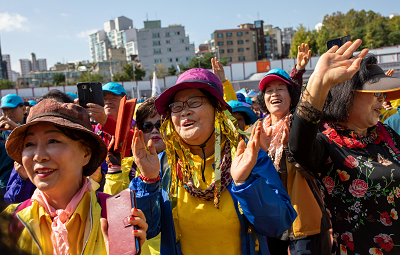[Sept] Ask Us about Korea: Trot music
Date Sep 01, 2021
 Senior citizens clap and dance to the songs performed by trot singer Kim Yong-im in Hyochang Stadium in Yongsan District, Seoul, Oct. 15, 2019. Photo by Shim Hyun-chulQ. K-pop’s popularity knows no borders, as fans all across the world enjoy it. But in Korea, is K-pop also popular among people of all ages?
Senior citizens clap and dance to the songs performed by trot singer Kim Yong-im in Hyochang Stadium in Yongsan District, Seoul, Oct. 15, 2019. Photo by Shim Hyun-chulQ. K-pop’s popularity knows no borders, as fans all across the world enjoy it. But in Korea, is K-pop also popular among people of all ages?
A. Older and younger Koreans, just like generations everywhere, have different tastes in music. In general, K-pop is popular among young music fans, although it’s difficult to define exactly when “young” stops and “old” begins. From the ages of band members and fans, it’s clear that K-pop is generally for younger generations. It covers several different genres of contemporary pop music, including hip-hop, R&B, electronic and rock.
Older Koreans tend to favor “trot.” This pop genre first appeared in the 1920s. A unique vocal technique called “kkeokk-ki” (flexing) differentiates trot from K-pop. Trot artists use lower notes in a vibrato, and their voices crack when they sing higher notes that push the limits of their vocal ranges.
Trot had its largest fan base in the 1960s and 1970s, a period marked by the long-lasting rivalry between two male trot stars: Nam Jin and Na Hoon-a. Many rumors spread about these singers as their respective fans often sparred over which one truly deserved to be called the best. Though now in their seventies, both singers are still active.
K-pop’s rise in the 1990s led to lean years for Trot musicians with K-pop being depicted as trendy and trot seen as “doomed.” Surprisingly, however, trot has had a comeback in the last few years – against all odds – after cable network TV Chosun’s audition reality show “Miss Trot” went viral in 2019 during its search for Korea’s next top trot singer. Since then, “Miss Trot” and its sequel “Mr. Trot” have dominated cable TV ratings. Following their successes, other networks have jumped on the trot bandwagon, airing TV shows that feature trot singers.
**“Ask Us about Korea” is a Q&A section about Korea and Korean culture. If you have any relevant questions, please send us an email (KOCIS@korea.kr). We’ll choose one of the questions sent by our readers and answer it in this section.**

The Ministry of Culture, Sports and Tourism's "Korea Here & Now" work can be used under the condition of "Public Nuri Type 1 (Source Indication)."




